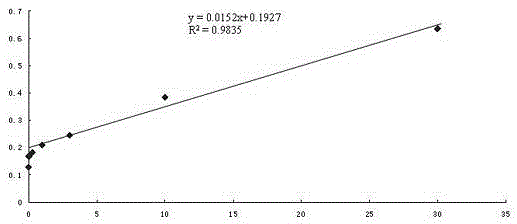Epitope peptide monoclonal antibody for tumor-related gene TP53 and application thereof
A monoclonal antibody and epitope polypeptide technology, applied in the direction of p53 protein, peptide, peptide source, etc., can solve the problems of dysfunction, high deletion rate of TP53 gene, etc., and achieve high sensitivity and high specificity
- Summary
- Abstract
- Description
- Claims
- Application Information
AI Technical Summary
Problems solved by technology
Method used
Image
Examples
Embodiment 1
[0018] Embodiment 1, establishment of hybridoma cell line
[0019] 1. Experimental materials
[0020] 1. Immunogen: In this case, the highly conserved protein sequence of the TP53 gene is used as the target protein to design and synthesize the epitope polypeptide. The TP53 epitope polypeptide: PGTRVRQSQHMTELIRVEC is prepared by chemical synthesis, and the purity requirement is greater than 95%. Epitope polypeptides were coupled with KLH to prepare immunogens.
[0021] 2. Culture medium: DMEM medium was purchased from Hyclone Company; HAT, HT selection medium and pristane were purchased from Sigma Company.
[0022] 3. Experimental animals: Balb / c mice, 8-12 weeks old, female, SPF grade animal culture.
[0023] 4. Other materials: Freund's complete adjuvant and Freund's incomplete adjuvant were purchased from Sigma Company; PEG4000 was purchased from Fluka Company; HRP-goat anti-mouse IgG antibody was purchased from JacksonImmune Company; other reagents were domestic analytica...
Embodiment 2
[0052] Embodiment 2 Preparation of monoclonal antibody against TP53 epitope polypeptide
[0053] Primary antibody preparation
[0054] Adult BALB / c mice were selected, and pristane was inoculated intraperitoneally, 0.5ml per mouse. After 7-10 days, the 16th generation hybridoma cells were inoculated intraperitoneally, 1×10 per mouse 6 -2×10 6 indivual. After an interval of 5 days, when the abdomen is obviously enlarged and the skin feels tense when touched with hands, the ascites can be collected with a No. 9 needle.
[0055] Centrifuge the ascitic fluid (13000r / min for 30 minutes), remove cell components and other precipitates, and collect the supernatant. Purify with ProteinG~SepharoseCL-4B, the upper column liquid is 20mM PBS buffer, and the eluent of column chromatography is: pH2.7, 20mM glycine buffer, to obtain the monoclonal antibody of TP53 epitope polypeptide (will be determined by the epitope The monoclonal antibody produced by the peptide sequence is called clone...
PUM
 Login to View More
Login to View More Abstract
Description
Claims
Application Information
 Login to View More
Login to View More - R&D
- Intellectual Property
- Life Sciences
- Materials
- Tech Scout
- Unparalleled Data Quality
- Higher Quality Content
- 60% Fewer Hallucinations
Browse by: Latest US Patents, China's latest patents, Technical Efficacy Thesaurus, Application Domain, Technology Topic, Popular Technical Reports.
© 2025 PatSnap. All rights reserved.Legal|Privacy policy|Modern Slavery Act Transparency Statement|Sitemap|About US| Contact US: help@patsnap.com



